Constellation Names, Mythical and Astrological Meanings. Ever wondered the Greek Mythology behind Astronomy? Constellations are patterns of stars in the night sky that have been identified and named by various cultures throughout history. They often hold significant mythological, cultural, and navigational importance.
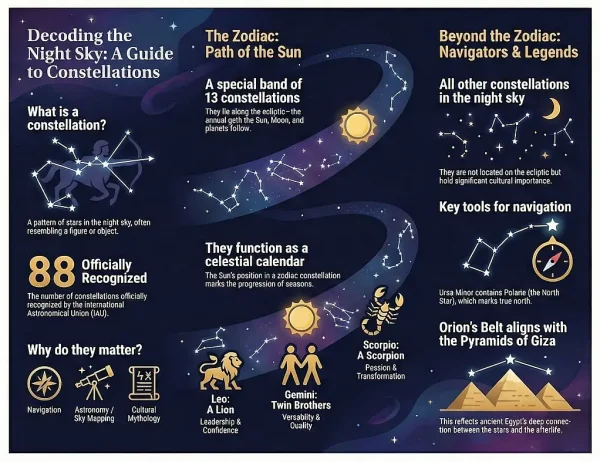

What are Constellations?
Constellations as mentioned in the intro, are patterns formed by groups of stars in the night sky that often resemble objects, animals, or mythological figures. They have been used throughout history as celestial maps to help navigate the sky and as a seasonal calendar to mark the passage of time.
Constellations names have served as celestial landmarks for millennia, guiding explorers and inspiring storytellers. In astronomy, they help scientists map the night sky, while in astrology, they influence horoscopes and personal traits. This blend of science and mythology showcases the profound impact these star patterns have on human culture and knowledge.
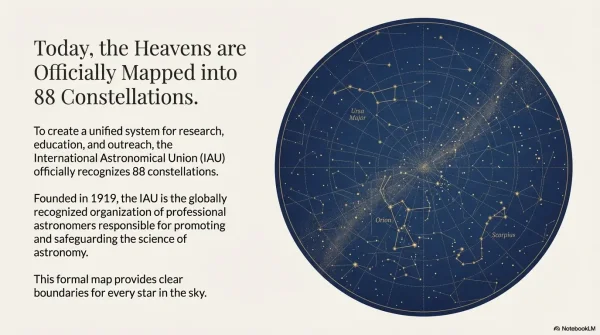
How many Constellations are there?
There are 88 constellations officially recognized by the International Astronomical Union (IAU). Founded in 1919, the IAU is a globally recognized organization of professional astronomers. Its primary objectives include promoting and safeguarding astronomy in all its aspects, including research, education, and public outreach.
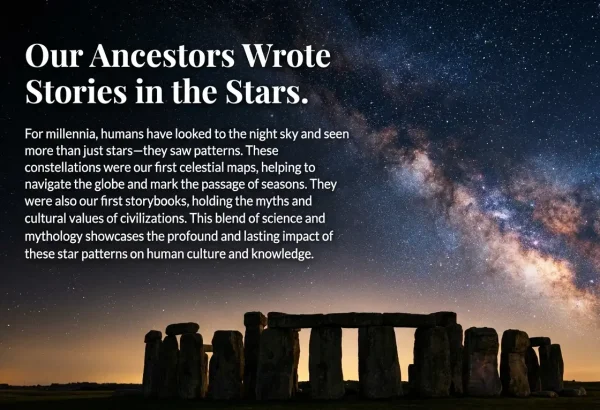
Types of Constellations: Zodiac and Non Zodiac
Throughout history, constellation names and their meanings have played significant roles in navigation, mythology, and cultural storytelling. In both astronomy and astrology, constellations are categorized as zodiac and non-zodiac, each serving unique purposes.

Zodiac Constellations
- Definition: Zodiac constellations are a band of 13 specific constellations with Zodiac signs that lie along the ecliptic or the path that the Sun, Moon, and planets follow throughout the year. With the exception of Ophiuchus, all of these constellations are integral to both astronomy and astrology.
- Astronomical Role: As the Earth orbits the Sun, different zodiac constellations become visible at different times of the year. This movement marks the progression of the months and seasons.
- Astrological Significance: Each zodiac constellation corresponds to a zodiac sign, which influences astrological readings and horoscopes.
Main 13 Zodiac Constellations: Mythical Meanings and Astrological Signs
| Zodiac Constellation Names | Greek Mythology | Constellation Description | Astrological Zodiac Signs |
|---|---|---|---|
Capricorn |
Represents a mythical creature that is half goat, half fish in Greek mythology | A faint zodiac constellation located in the southern sky. | Associated with the Capricorn zodiac sign (December 22 - January 19), symbolizing discipline, ambition, and responsibility. |
Aquarius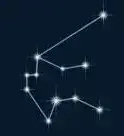 |
Represents a water-bearer in Greek mythology | A large, faint zodiac constellation, notable for its association with water. | Associated with the Aquarius zodiac sign (January 20 - February 18), symbolizing innovation, humanitarianism, and independence. |
Pisces |
Represents two fish in Greek mythology | A faint zodiac constellation located in the northern celestial hemisphere. | Associated with the Pisces zodiac sign (February 19 - March 20), symbolizing empathy, intuition, and artistic creativity. |
Aries |
Represents a ram in Greek mythology | A zodiac constellation located in the northern celestial hemisphere. Its brightest star is Hamal. | Associated with the Aries zodiac sign (March 21 - April 19), symbolizing courage, initiative, and leadership. |
Taurus |
Represents a bull in Greek mythology | Contains the bright star Aldebaran and the Pleiades star cluster, making it one of the most distinctive constellations in the sky. | Associated with the Taurus zodiac sign (April 20 - May 20), symbolizing determination, reliability, and sensuality. |
Gemini |
Represents twin brothers Castor and Pollux in Greek mythology | Features two bright stars, Castor and Pollux, symbolizing the twins. It's located near Orion. | Associated with the Gemini zodiac sign (May 21 - June 20), symbolizing versatility, communication, and duality. |
Cancer |
Represents a crab in Greek mythology | A faint constellation, but notable for the Beehive Cluster (M44), an open star cluster visible to the naked eye. | Associated with the Cancer zodiac sign (June 21 - July 22), symbolizing sensitivity, emotional depth, and nurturing. |
Leo |
Represents a lion in Greek mythology | One of the zodiac constellations, easily recognizable by the bright star Regulus, which forms part of the lion's mane. | Associated with the Leo zodiac sign (July 23 - August 22), symbolizing leadership, confidence, and creativity. |
Virgo |
Represents a maiden or virgin in Greek mythology | The second-largest constellation in the sky, home to the bright star Spica and part of the Virgo Cluster of galaxies. | Associated with the Virgo zodiac sign (August 23 - September 22), symbolizing purity, service, and analytical prowess. |
Libra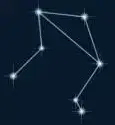 |
Represents a pair of scales in Greek mythology | A faint constellation, located between Virgo and Scorpius, it's notable for its association with balance and justice. | Associated with the Libra zodiac sign (September 23 - October 22), symbolizing harmony, fairness, and relationships. |
Scorpio |
Represents a scorpion in Greek mythology | One of the most recognizable constellations, featuring a curved line of stars and the bright star Antares. | Associated with the Scorpio zodiac sign (October 23 - November 21), symbolizing passion, intensity, and transformation. |
Sagittarius |
Represents a centaur archer in Greek mythology | Located in the direction of the Milky Way's center, home to many star clusters and nebulae like the Lagoon Nebula. | Associated with the Sagittarius zodiac sign (November 22 - December 21), symbolizing exploration, adventure, and philosophical pursuits. |
| Ophiuchus | Represents a serpent-bearer in Greek mythology | Located near the celestial equator, Ophiuchus is often called the "13th zodiac sign, " though not officially part of astrology's 12 signs. | While not traditionally included in the zodiac, some modern interpretations suggest it could influence personality traits like healing, wisdom, and renewal. |
Non Zodiac Constellations
- Definition: Non-zodiac constellations do not lie along the ecliptic and are not associated with astrological zodiac signs. However, they hold great importance in mythology, navigation, and astronomy.
- Astronomical Role: Non-zodiac constellations are scattered across the night sky and are visible depending on the time of year and geographic location. They are often used to locate deep-sky objects like star clusters and nebulae.
- Mythological and Cultural Significance: Many non-zodiac constellations are named after figures from Greek, Roman, and other mythologies. For example, Orion, the hunter, is one of the most well-known constellations, and its three-star belt is a striking feature of the night sky. Similarly, Ursa Major and Ursa Minor (the Great and Little Bears) are tied to navigation, with Polaris (the North Star) marking true north.
7 Non Zodiac Constellations: Astronomy from Greek Mythology
| Non-Zodiac Constellation Names | Roots in Greek Mythology | Constellation Description | Astronomical, Mythological |
|---|---|---|---|
| Orion | Named after a Greek hunter | Features the famous Orion Nebula and the three stars of Orion's belt. | Astronomical and mythological |
| Ursa Major | Means "Great Bear" in Latin | Home to the Big Dipper asterism, it's one of the most recognizable constellations. | Navigational and cultural |
| Ursa Minor | Means "Little Bear" in Latin | Contains Polaris, the North Star, crucial for navigation. | Navigational |
| Cassiopeia | Named after a queen in Greek mythology | Recognizable for its W shape, it's near the North Star. | Mythological |
| Andromeda | Named after a princess in Greek mythology | Contains the Andromeda Galaxy, the closest spiral galaxy to the Milky Way. | Astronomical |
| Cygnus | Represents a swan in Greek mythology | Contains the Northern Cross asterism and is prominent in summer skies. | Astronomical |
| Pegasus | Named after the winged horse in Greek mythology | Recognized by the Great Square of Pegasus. | Mythological |
Constellations, both main 13 zodiac and the 7 non-zodiac, are not only vital for astronomical navigation but also enrich our cultural heritage through their ties to mythology and astrology. Understanding the meanings and significance behind these celestial patterns deepens our appreciation for the night sky and its role in human history. Understanding constellations enriches our appreciation of the night sky and connects us to the stories and knowledge of ancient civilizations.
Importance of Constellation names and Constellation Meaning
- Navigation: Historically used by sailors and travelers to determine direction.
- Cultural Significance: Reflects the mythology and values of different civilizations.
- Astronomy: Helps in mapping the sky and locating stars, planets, and other celestial objects.
Historical and Mythical Usage of Constellations
Different civilizations have utilized constellations for various purposes beyond navigation. For example, the ancient Greeks used constellations in their mythology to explain natural phenomena and to pass down cultural stories. Similarly, ancient Egyptians aligned their pyramids with specific stars and constellations, integrating them into their religious and cultural practices.
Cosmic Alignment Between Thoth, Hermes, & Enoch?
In the world of mythology, the figures of Thoth, Hermes, and Enoch often overlap, serving as symbols of knowledge, wisdom, and communication. While each comes from a distinct cultural tradition, they all share a deep connection to the stars, and their mythologies align with the celestial constellations in ways that reflect their roles as messengers, guides, and seekers of hidden wisdom. In fact, these figures may all represent the same archetype, a universal expression of the divine messenger and keeper of esoteric knowledge.
Thoth, in Egyptian mythology, was the god of wisdom, writing, and the moon. He was believed to govern the stars and helped humans decipher the secrets of the cosmos. Thoth's association with the moon connects him with the cycle of the moon's phases, mirroring the subtle changes and wisdom that come with time, something deeply tied to the symbolism of certain constellations.
Hermes, in Greek mythology, shared similar attributes, often referred to as the god of communication, trade, and wit. He was also a psychopomp, guiding souls to the afterlife. Like Thoth, Hermes had an inherent connection to the celestial realms, often depicted with his winged sandals, suggesting his swift movement between worlds, both earthly and divine. One might look to the constellation Gemini, which represents the twins Castor and Pollux, often seen as symbols of duality and the transcendence of boundaries. Gemini can be linked to Hermes' role as a messenger, moving between realms with ease.
Enoch, from the Hebrew Bible, is similarly associated with esoteric wisdom. In the Book of Enoch, he is depicted as someone who walks with God and gains divine knowledge of the heavens. The connection to the stars here is explicit: Enoch is often thought to have been taken up to the heavens, where he received wisdom from the divine beings. This heavenly ascent can be tied to the constellation of Aquarius, the water-bearer, which symbolizes spiritual enlightenment and the flow of divine knowledge, akin to the wisdom Enoch received.
These figures are often seen as different faces of the same cosmic archetype. They represent the keeper of wisdom, the communicator of the divine, and the one who bridges the heavens and earth. Their association with specific constellations reflects the profound relationship between mythological symbolism and the stars.
For more on the connection between Thoth, Hermes, and Enoch, and how these figures represent one and the same celestial messenger, you can explore my detailed post here: Thoth, Hermes, and Enoch: Same Cosmic Archetype.
Orion's Belt and the Great Pyramids of Egypt
- The three stars of Orion's Belt, Alnitak, Alnilam, and Mintaka do align remarkably with the layout of the three main pyramids at Giza: Khufu, Khafre, and Menkaure. Ancient Egyptians believed that the stars were connected to their gods, specifically the god Osiris, associated with rebirth and the afterlife, giving Orion Constellation meaning.
- This alignment represents the Egyptians' deep belief in the heavens and their integration of astronomical knowledge with religious and cultural symbolism. The pyramids were seen as a way to bridge the physical world with the spiritual world above.

Constellation meanings bridge the gap between the scientific exploration of the cosmos and the rich mythological narratives that have been passed down through generations. Whether used for navigation, storytelling, or personal reflection through astrology, these star patterns continue to inspire and guide us. Embracing both their astronomical significance and their mythological roots allows us to appreciate the night sky's beauty and the enduring legacy of human curiosity and imagination.